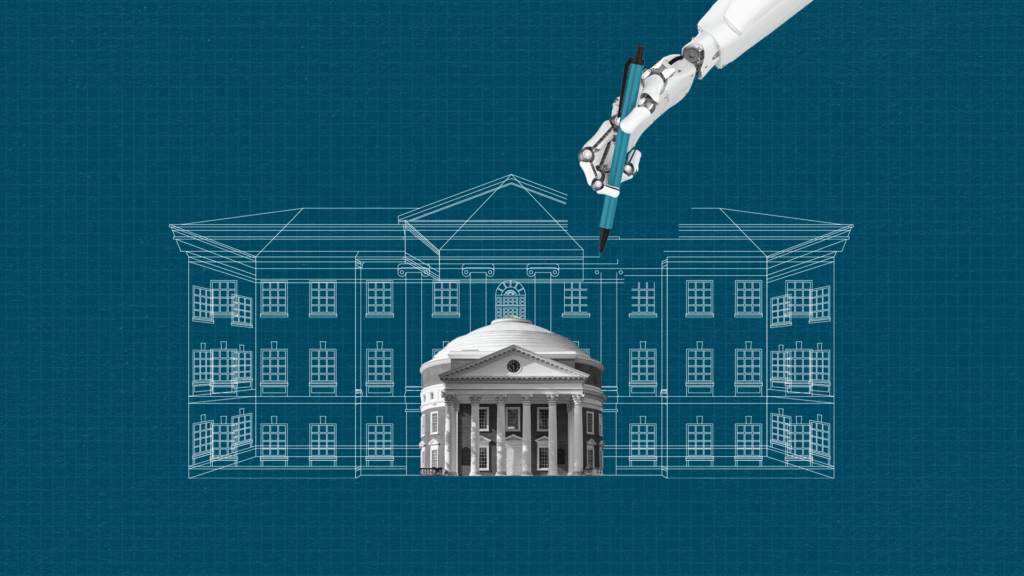In our previous article, “Why AI Literacy is the New Core Skill”, we explored AI literacy: what it means and why it’s important. Now, we’ll briefly look at how higher ed is doing in terms of preparing students for employment and how AI can enhance the student experience before looking at a few examples of how institutions are putting AI to work for their students and for industry.
Industry Dissatisfaction with Graduates’ AI Literacy
Any major disruption—from pandemics to the rise of AI—unleashes a kind of productive chaos. Ideas don’t emerge fully formed; they grow from moments like these, when boundaries shift, information floods in, and we’re forced to explore, connect, and eventually let go—until something new takes root. In these moments, industry often looks to higher education to adapt quickly—to become more agile, collaborative, and future-ready in how it educates, innovates, and serves learners.
So, how is higher education doing? In a recent piece on AI integration, Beth McMurtrie of The Chronicle of Higher Education described the current environment like this:
More than two years after ChatGPT stunned the world with its speed and fluidity, much of higher education remains in a reactive mode. A handful of institutions have invested heavily in AI tools and training, but many colleges cannot afford the expense. Plenty of faculty members have attended workshops and experimented with AI in their teaching, but campuswide strategies and departmental and disciplinary discussions have been limited. A survey conducted in November by Educause, a nonprofit focused on technology in higher education, found that only 22 percent of respondents said their college had an institutionwide approach toward AI.
Jessica Stansbury of the University of Baltimore adds:
I think what happens is we hear AI literacy and everyone’s like, ‘Yes! We have to put this in the curriculum right away!’’’ Stansbury said. “That’s where the faculty resistance and that fear come in, because it’s like, ‘Well, for what? I don’t need to have this in my profession.’ But business might need to have it, or law might need to have it. So let us take a step back and reach out and figure out what it is for them, so we can build something that makes sense for us.
How Higher Ed Must Respond
As noted, major societal or technical disruptions that impact industry create a variety of challenges for higher education, not least of which is the immediate need for skilled graduates. While professionals across categories hurry to learn what they can about AI and how to put it to work in their jobs, teachers throughout our education system must learn all of that PLUS how to teach AI principles and techniques either as a focus or in the context of their primary subjects.
If we take it as a given that AI will become an integral part of the workplace, educators must prepare students with frameworks for responsible use and implementation. While working any new ideas or technology into existing curricula is challenging, keeping the expectations of our ultimate customer (industry) at the fore will help us develop the next generation of industry-ready graduates:
Rapid Adoption and Integration of Emerging Technologies
Industry generally anticipates that higher education will not only adopt new technologies—such as AI, quantum computing, and digital credentials—but also integrate them meaningfully into curricula, research, and administration to enhance educational quality and relevance. Institutions can also demonstrate their commitment through supportive leadership, enthusiastic faculty, comprehensive policy statements, and the utilization of AI for internal functions.
Alignment with Workforce Needs
Educational programs should be flexible, interdisciplinary, and designed to equip students with practical skills for emerging industries and technologies. This requires a focus not only on the hard skills associated with a particular program, but also the soft skills needed to navigate the modern workforce. While AI is the hot button topic of the day, it is critical that institutions monitor social change as well as technological change in order to keep learning content and modalities current and consistent with industry demand.
Collaboration and Ecosystem Building
Collaboration between industry and higher education is critical for providing students with relevant skills, practical experience, and real-world understanding of the role of AI in a given industry. Engaged employers can help shape curricula, offer internships, and provide mentoring that helps prepare students for immediate entry into the workforce with up-to-date, in-demand skills. This creates a strategic talent pipeline of new candidates, reduces recruitment and training costs, and improves employee retention. For students, industry partnerships offer hands-on learning, exposure to current industry trends, and valuable networking opportunities, making them more competitive in the job market.
Measurable Impact and Continuous Improvement
Industry expects higher education to measure the impact of innovation using clear indicators, ensuring that changes lead to tangible improvements in student outcomes, employability, and institutional effectiveness (more on the importance of regular refreshing of curricula).
Enhancing the Student Experience with AI
Including AI tools in online courses enhances the learning experience by providing students with cutting-edge skills and exposure to real-world applications. AI tools like chatbots or virtual teaching assistants can provide students with personalized, responsive learning experiences, increasing engagement and performance. This allows for:
Personalized learning pathways using AI-powered tools, leading to:
- Improved Academic Performance: Studies have demonstrated that personalized learning platforms utilizing AI can lead to significant improvements in student learning outcomes. For example, research indicates that students using such platforms achieved up to a 50% increase in math learning outcomes compared to traditional methods.
- Enhanced Student Engagement: AI-driven personalized content has been shown to increase student motivation and active participation by 20% compared to traditional lecture-based instruction, leading to better learning engagement.
Adaptive assessments and feedback systems, leading to:
- Real-Time Feedback: AI-enabled systems provide instant feedback, allowing learners to understand and correct their mistakes promptly. This immediate response facilitates continuous improvement and deeper understanding.
- Dynamic Assessment Adjustments: Adaptive assessments powered by AI adjust their difficulty based on a learner’s performance, ensuring that challenges are appropriately matched to the learner’s current skill level, promoting optimal learning conditions.
- Personalized Feedback: Automated, data-driven feedback tailored to individual student needs has been linked to considerable improvements in learning outcomes. Research indicates that personalized feedback leads to significant gains in student learning and satisfaction.
Access to real-time data analytics on student progress, leading to:
- Continuous Monitoring: AI systems analyze student interactions and performance data to monitor progress in real-time, enabling timely interventions and support where necessary.
- Informed Decision-Making: Educators can leverage AI-generated analytics to make data-driven decisions regarding instructional strategies and identify areas where students may need additional assistance, enhancing the overall educational process.
How Schools are Doing It
University of Virginia
Faculty AI Guides is an initiative designed to advance the understanding of generative AI and to empower faculty to make informed and intentional decisions about the role of generative AI in their teaching.The 2024-2025 cohort of Faculty AI Guides consists of 51 faculty from departments and schools across Grounds. They are actively exploring the use of AI in their own teaching contexts, and they are sharing what they learn with colleagues in their disciplines and areas through individual and informal consultations as well as workshops, department presentations, and lunch-and-learns.
Faculty AI Guides participate in a two-day institute on AI and teaching, meet monthly in small teams to learn from and with each other, and are supported by faculty and staff from UVA’s Center for Teaching Excellence.
University of Florida
“AI Across the Curriculum” integrates artificial intelligence education into every major, ensuring all students—regardless of discipline—graduate with foundational AI literacy and the option to pursue deeper expertise. The initiative includes over 230 AI and data science courses across UF’s 16 colleges, supported by more than 100 new AI-focused faculty, and offers both foundational and discipline-specific AI certificates. The curriculum emphasizes four core areas: understanding AI, applying AI, evaluating and creating AI, and AI ethics, preparing students for the evolving workforce and making UF a national model for AI education
Georgia Institute of Technology
“Jill Watson,” an AI-powered teaching assistant, was deployed in an online computer science course to answer students’ routine questions resulting in significantly reduced response times and teaching staff workload, while maintaining consistent student support.
Ivy Tech Community College
Implemented an AI system across its 45 Indiana locations to identify at-risk students early in the semester and facilitate targeted interventions. Ivy Tech’s student body experienced reduced failure rates, with 98% of identified students improving to at least a C grade.
Stanford University
Stanford rolled out adaptive learning platforms that tailor content and pace to each student’s performance leading to increased course completion rates and higher student satisfaction, especially in high-enrollment and challenging courses.
AI for Your Institution
There is no one-size-fits-all approach for integrating AI into college curricula, but integrate it we must. Noodle has engaged with numerous institutions to develop AI training and integration programs, all beginning with a comprehensive needs assessment evaluating existing AI programs and prioritizing key degree programs for immediate attention. Our experts become an extension of your own team, providing ongoing training, monitoring, and evaluation. Together, we can develop custom solutions that provide the best outcomes for your students, your industry colleagues, and your institution itself.



